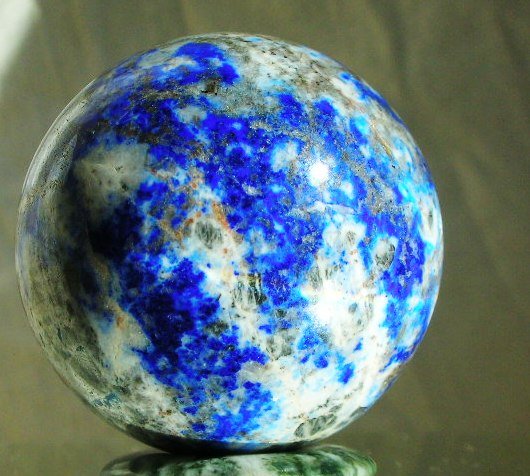Video of Lazurite sphere
Sphere made from Lazurite

Wednesday, March 7, 2007
Lazurite or Lapis lazuli - what is a different?
Lazurite is a merchandise of link metamorphism of limestone and typically is associated with calcite, pyroxenes, and pyrite. Other dark minerals such as the carbonate azurite and the phosphate lazulite may be confused with lazurite, but are well distinguished with cautious testing. Lazurite at one moment was used as a synonym for azurite. Lazurite was first described in 1890 from the lapis lazuli territory of Badakhshan, Afghanistan. The only large deposite of Lazurite is at Tultui lazurite deposit, Malaya Bystraya River, Tunka Valley, Sludyanka (Slyudyanka), Baikal area, Buriatia (Buryatia) Republic, Transbaikalia (Zabaykalye), Eastern-Siberian Region, Russia (watch a Google video).
Lazurite is a favorite but mostly costly mineral. Well-formed, profound dark crystals are uncommon and invaluable. It is more usually establish big and combined with new minerals into a stone called lapis lazuli. Lapis lazuli or lapis for brief is largely lazurite but usually contains pyrite and calcite and some new minerals. The figure means "dark stone" and is ever a superb blue with purple or greenish tints. The wealthy dark tone is payable to the sulfur that is implicit in the system of lazurite. Small crystals of pyrite are ever existing in lapis and their gaudy yellow tone is both appealing and diagnostic in distinguishing lapis from its too dark cousin - sodalite stone, which lacks pyrite. The calcite produces light-colored streaks in the lapis and overly more calcite will depress the value of the rock.
Lazurite is a favorite but mostly costly mineral. Well-formed, profound dark crystals are uncommon and invaluable. It is more usually establish big and combined with new minerals into a stone called lapis lazuli. Lapis lazuli or lapis for brief is largely lazurite but usually contains pyrite and calcite and some new minerals. The figure means "dark stone" and is ever a superb blue with purple or greenish tints. The wealthy dark tone is payable to the sulfur that is implicit in the system of lazurite. Small crystals of pyrite are ever existing in lapis and their gaudy yellow tone is both appealing and diagnostic in distinguishing lapis from its too dark cousin - sodalite stone, which lacks pyrite. The calcite produces light-colored streaks in the lapis and overly more calcite will depress the value of the rock.
Subscribe to:
Comments (Atom)